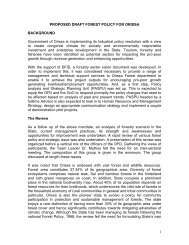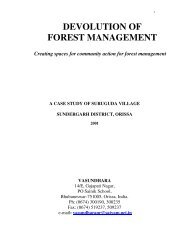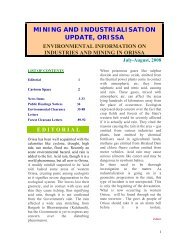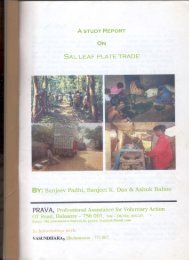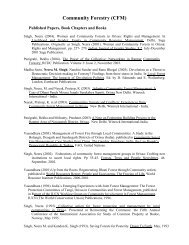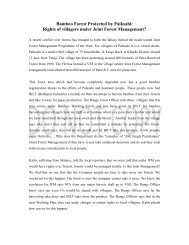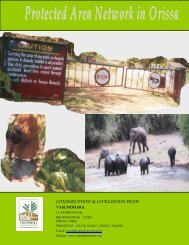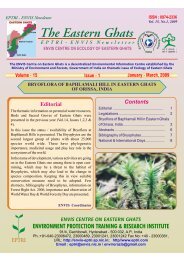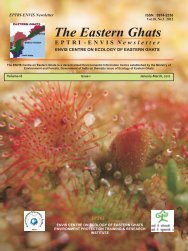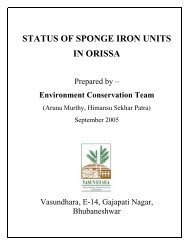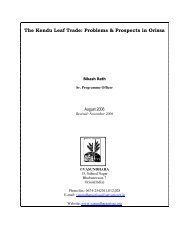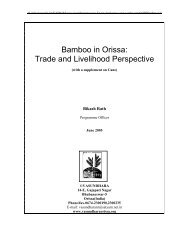Impact of NTFP ban on the lives and livelihood of the ... - Vasundhara
Impact of NTFP ban on the lives and livelihood of the ... - Vasundhara
Impact of NTFP ban on the lives and livelihood of the ... - Vasundhara
Create successful ePaper yourself
Turn your PDF publications into a flip-book with our unique Google optimized e-Paper software.
MethodologyMethodology for <strong>the</strong> studies taken up in <strong>the</strong> PAs:A number <str<strong>on</strong>g>of</str<strong>on</strong>g> methodological tools were used to achieve <strong>the</strong> above. These were Qualitative as well asQuantitative in nature:1. Building <strong>on</strong> available informati<strong>on</strong>, carrying out <strong>the</strong>oretical analysis <str<strong>on</strong>g>of</str<strong>on</strong>g> latest policy directives, t<str<strong>on</strong>g>of</str<strong>on</strong>g>ind out <strong>the</strong> various c<strong>on</strong>tradicti<strong>on</strong>s <strong>and</strong> complementaries in <strong>the</strong> related laws <strong>and</strong> to assess how<strong>the</strong>se directives are impacting <strong>livelihood</strong> security <str<strong>on</strong>g>of</str<strong>on</strong>g> communities dependent <strong>on</strong> protected areas.2. Undertaking field visits to selected protected areas, to underst<strong>and</strong> l<strong>and</strong>scape c<strong>on</strong>servati<strong>on</strong>initiatives <strong>and</strong> to find out <strong>the</strong> impact <str<strong>on</strong>g>of</str<strong>on</strong>g> <strong>the</strong> Supreme Court order <strong>on</strong> <strong>the</strong> <strong>lives</strong> <strong>and</strong> <strong>livelihood</strong> <str<strong>on</strong>g>of</str<strong>on</strong>g><strong>the</strong> people.3. Analysis <str<strong>on</strong>g>of</str<strong>on</strong>g> available databases <strong>on</strong> PAs, including raw data collected from different PAs. Whereavailable, o<strong>the</strong>r sec<strong>on</strong>dary data <strong>on</strong> socio-ec<strong>on</strong>omic aspects were also used.4. Discussi<strong>on</strong>s with high-level <str<strong>on</strong>g>of</str<strong>on</strong>g>ficials at <strong>the</strong> central Ministry <str<strong>on</strong>g>of</str<strong>on</strong>g> Envir<strong>on</strong>ment <strong>and</strong> Forests <strong>and</strong>within <strong>the</strong> state, <strong>and</strong> with selected nati<strong>on</strong>al <strong>and</strong> state level NGOs, community leaders, <strong>and</strong>independent c<strong>on</strong>servati<strong>on</strong>ists/social activists. Primary data <strong>and</strong> informati<strong>on</strong> were collectedthrough st<strong>and</strong>ard methodology tools such as interviews <strong>and</strong> questi<strong>on</strong>naires, <strong>and</strong> analyzed.Opportunities for participating in workshops <strong>and</strong> c<strong>on</strong>sultati<strong>on</strong>s <strong>on</strong> <strong>the</strong>se issues were also availed <str<strong>on</strong>g>of</str<strong>on</strong>g>.Finally, but not least, our existing network <str<strong>on</strong>g>of</str<strong>on</strong>g> c<strong>on</strong>tacts <strong>and</strong> associated organizati<strong>on</strong>s in specific areaswere tapped, to get informati<strong>on</strong>, help with insights <strong>and</strong> analysis, <strong>and</strong> bounce <str<strong>on</strong>g>of</str<strong>on</strong>g>f research results.Collecti<strong>on</strong> <str<strong>on</strong>g>of</str<strong>on</strong>g> <strong>the</strong> primary level data, household surveys were d<strong>on</strong>e in a participatory method with <strong>the</strong>local facilitators, volunteers etc. The preparati<strong>on</strong> <str<strong>on</strong>g>of</str<strong>on</strong>g> study design, detailed questi<strong>on</strong>naire, methodologyto c<strong>on</strong>duct <strong>the</strong> study were d<strong>on</strong>e by us with <strong>the</strong> help <str<strong>on</strong>g>of</str<strong>on</strong>g> c<strong>on</strong>sultants (WWF) <strong>and</strong> our local levelnetworks. Field visits <strong>and</strong> survey were d<strong>on</strong>e by <strong>Vasundhara</strong> staff al<strong>on</strong>g with <strong>the</strong> local volunteers,people’s instituti<strong>on</strong>s <strong>and</strong> facilitators. The collected informati<strong>on</strong> was thoroughly scrutinized at everylevel <strong>and</strong> correcti<strong>on</strong>s were made after verificati<strong>on</strong> at <strong>the</strong> ground level <strong>and</strong> repeated c<strong>on</strong>sultati<strong>on</strong>s with<strong>the</strong> villagers <strong>and</strong> local groups. The case studies were designed accordingly which would help inchallenging <strong>the</strong> c<strong>on</strong>tradictory policies.While carrying out any studies, our primary goal was to capacitate <strong>the</strong> grass root level instituti<strong>on</strong>s,individuals <strong>and</strong> local people so that <strong>the</strong>y can take up <strong>the</strong>ir issues at <strong>the</strong>ir own end <strong>and</strong> skill withoutany external help, hence every step <str<strong>on</strong>g>of</str<strong>on</strong>g> all our interventi<strong>on</strong>s <strong>and</strong> studies were <strong>on</strong> a participatory basis.5



